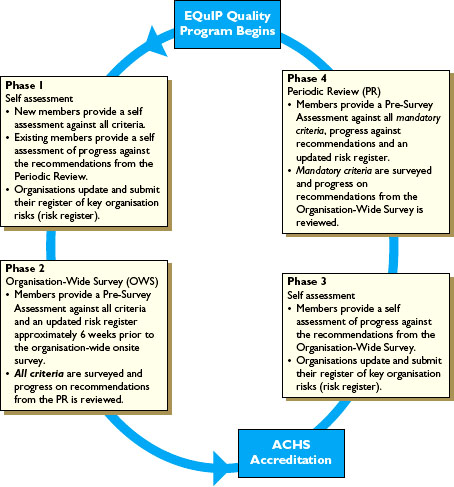Quality improvement processes for nurses
Nurses should strive to provide care which is evidence-based, culturally appropriate, client-centred and designed to achieve optimal clinical outcomes and organisational efficiencies. The primary goal of quality improvement programs should be the ongoing improvement of the delivery, quality, efficiency and outcome of patient care and services. This is accomplished through a systematic examination of information generated through ongoing monitoring, evaluation and quality-improvement activities. Organisations should strive to promote a culture that enables critical review of practice and a no-blame culture promoting review and development of nursing practice. All quality activities should be benchmarked in accordance with core nursing competencies, scope of practice and regulatory, ethical and legal frameworks. Box 8-6 provides examples of quality-improvement initiatives. Figure 8-1 provides a conceptual model for an iterative and reflective process for engaging in processes to improve nursing care delivery.
BOX 8-6 EXAMPLES OF GOALS FOR IMPROVEMENT IN CLINICAL CARE
• Increase the rate of smoking cessation programs to clients identified as smokers
• Improve identification of patients at risk for falls
• Reduce utilisation of restraints
• Initiate appropriate isolation precautions upon identification of established criteria
• Decrease delay in transfer to the clinical area from the emergency department

FIGURE 8-1 EQuIP5 quality cycle.
From Australian Council on Healthcare Standards (ACHS). 2010 The EQuIP guide, ed 5. Sydney, ACHS. Reproduced with permission.
The Australian Council on Healthcare Standards (ACHS) is an independent, not-for-profit organisation dedicated to improving the quality of healthcare in Australia. The ACHS is the principal independent authority for measuring and implementing quality-improvement systems in Australian healthcare. The ACHS Evaluation and Quality Improvement Program (EQuIP), launched in 1996, provides healthcare organisations with a continually updated framework to deliver a consumer-centred service focusing on the continuum of care by incorporating systematic external peer review. In addition to organisational quality indicators, there is an increasing emphasis on the unique role that nurses play in achieving optimal health-related outcomes.
John is an RN working in a community nursing centre. He notices that the referrals from the acute aged-care ward are not providing sufficient information to effectively prioritise and deliver care. He finds that he is wasting time chasing up discharge summaries and is concerned that the medication lists are not always appropriate. John raises this at the team meeting, and the NUM suggests that he liaise with the acute care ward to coordinate a quality project to improve the quality of the discharge summary.
1. How would you advise John to approach this topic?
2. Who should John choose to be on the project team?
3. Can you suggest some data items that might reflect that the quality of the discharge summaries have improved? Consider the key competencies of ’provision and coordination of care’ and ‘collaborative and therapeutic practice’ in Box 8-3.
Nursing-sensitive indicators
Increasing the emphasis on guaranteeing the quality of care, ensuring financial efficiencies and evaluating the diversity of skill mix in the healthcare setting have led to the development of outcome indicators that are sensitive to nursing interventions and staffing levels. Nursing-sensitive outcomes are defined as changes in health status upon which nursing care has had a direct influence. Variables affecting patient outcomes include diagnosis, socioeconomic factors, family support, age and gender, and the quality of care provided by other professionals and support workers.
Examples of nursing-sensitive indicators include:
• adverse events such as urinary tract infections, pressure ulcers, hospital-acquired pneumonia and deep vein thrombosis/pulmonary embolism
• wound infection and respiratory failure in surgical patients, and
• failure to respond to deterioration in clinical conditions such as shock, cardiac arrest and deep vein thrombosis, also known as failure to rescue.
The use of nursing-sensitive outcome indicators helps to focus attention on the safety and quality of patient care, and is important in demonstrating the critical difference that nurses make in providing safe and effective clinical care. Studies comparing staffing levels and patient outcomes show that when there is a greater proportion of RNs in the skill mix, there are fewer adverse events, fewer complications, shorter lengths of stay, decreased mortality rates and even lower overall costs (Twigg and others, 2010b). Higher levels of nursing personnel are associated with fewer adverse effects such as urinary tract infections, pneumonia and upper gastrointestinal bleeding.